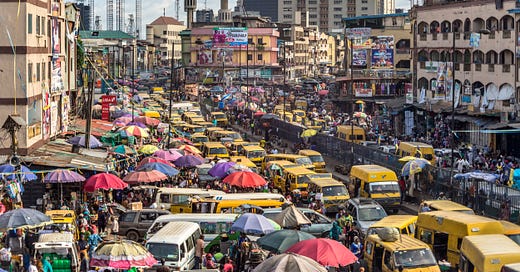The view is elevated. In almost every case, I can see the top of the buses, which stretch along the frame, as well as the rims of canopies. The view is also panoramic, which does not mean I have a three-dimensional view, but that I see things in every direction of the rectangular picture, across each inch of space, such that even the sweep of sky from edge to edge seems like an afterthought in the cityscape. Looking towards the cluster of buildings on the right, there is an additional combustive mix of persons and vehicles. As such, the houses, as they rise with staid oversight, are landmarks for the passage of traffic. It is somewhat possible to imagine these buildings without occupants, surrounded as they are by a repeated onslaught of gazes.
— Emmanuel Iduma
“In Lagos, you have to be creative to survive.”
The photograph was taken in Lagos Island in Idumota, which has so many layers of architecture and human configuration, and shows how people negotiate space in the city of Lagos. It’s a city of 20 million people and yet the space is not adequate. If you look behind in the photo you’ll see the commercial parts of Lagos Island, including areas like Broad Street, the Central Bank of Nigeria building, a church, a mosque. In one image, you see religious icons, commercial icons, and people negotiating the space.
Lagos is so built in. It’s a cacophony of different things together. It seems like it wasn’t planned since you don’t see any areas laid out for pedestrians to walk. You just have to be witty to negotiate with all kinds of things going on in front of you.
In Lagos, you have to be creative to survive. That is also reflected in how I photographed the image. It’s a space notorious for area boys. You can’t just pull out your camera. To take the photo, I had to go on a bridge, spend time observing the configuration of the space, and see if the coast was clear for me to shoot. I was very discreet. It’s another indication of how the city shapes the way you move in spaces. I don’t think I spent up to 15 seconds taking the picture. Spending more time could lead to a bigger problem. Even if it was difficult to shoot, I still wanted that image. Because it is reflective of the notion I want to portray in Mutations.
Photography is a powerful tool to communicate. It’s a language that can connect to everybody and as such I see it as a tool that can have an impact in sending messages, entertaining people, evoking emotions. How do you imagine what you look like except through the mirror or through the image of a photograph? I find it a blessing to have the power to reflect society as a form of conversation, expression, and hopefully as a form of advocacy. It’s a means of communication, in simple terms.
— Andrew Esiebo
About Andrew Esiebo
Andrew Esiebo is a visual storyteller whose practices investigate themes such as sexuality, football, popular culture, urbanism, migration, religion, and spirituality. He is based in Nigeria, from where he works around the world. His work has been widely exhibited, including at: the São Paulo Biennial, Brazil; the Biennale Cuvee, Linz, Austria; the Photo Quai biennials, Paris, France; the Dakart Biennale, Senegal; the Guangzhou Triennial, Beijing, China; the Chobi Mela V Photo Festival, Bangladesh; the Havana Biennial, Havana, Cuba; the Arles Photo Festival; the Breda Photo Festival, the Netherlands; and the Kent University Museum, USA. His works are in several private and public art collections. More of his work on his website, and Instagram.
LAST WEEK: “Kenya, 1996,” by Robert Lyons
I have kept journals of my travels throughout the past nine years. Sometimes I’ve only notated names and addresses of individuals to whom I wish to send or bring back photographs; at other times, views of a particular time and place.
This is the 98th edition of this publication, which also read on web (best for viewing images), and via the Substack iOS/Android apps.
TENDER PHOTO is a bi-weekly newsletter on African photography. Every Wednesday we feature a photograph and a short caption about it, and include a statement from the photographer. Every Friday, we publish commentaries or photo-essays in response to photographs previously featured on the newsletter. The most recent series is INDEX. Our goal is to work with African photographers by creating a platform in which they lead the cataloguing and engagement with their work.
Thank you for reading. If this newsletter was shared with you, consider subscribing, or forward to a friend. Please whitelist the newsletter to ensure you never miss it.






That's quite a photo.
Wow ... I stayed more than 3 minutes in front of this photo, looking for all the details after reading the text! Stunning!